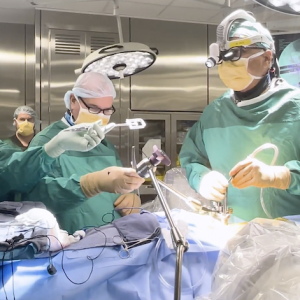Little Orphan Annie said you were never fully dressed without a smile, but that means many people who have suffered tooth loss can feel woefully underdressed each day. We spoke with oral surgeons working on grins around the Gulf Coast about what patients need to know regarding replacements in the absence of original pearly whites.
Are implants a purely cosmetic choice? Is there a health benefit to replacing missing teeth?
Dr. Craig Misch, oral surgeon, Misch Implant Dentistry: Studies have found a correlation between tooth loss, chronic disease and longevity. It makes sense – tooth loss may contribute to nutrition problems by limiting the types of foods you can eat. When you lose a tooth, the adjacent teeth will eventually shift into the space. This can affect your bite as the cusps are not properly aligned. It will also make the adjacent teeth more prone to decay and gum disease as it is much harder to keep them clean. When teeth are removed, the bone that supports the roots tends to resorb or shrink over time. The use of partials and dentures for tooth replacement places added stress on the bone leading to further jaw deterioration and facial changes. Dental implants actually stimulate and help maintain the jawbone. There is obviously a cosmetic concern with tooth loss as well. People lose self-esteem and become embarrassed to smile. A full smile projects youthfulness and health. Dr. Todd Reuter, oral surgeon, Sarasota Oral and Implant Surgery: While certainly there is a cosmetic benefit to replacing teeth, dental implants provide a much more important functional benefit. Missing teeth that result in gaps can cause other teeth to shift and a patient’s bite to deteriorate over time. This may cause difficulty with eating and speech and could lead to muscle, joint or nerve pain. For patients wearing dentures, implants can dramatically improve taste and chewing ability. Literature has shown that replacing missing teeth improves nutrition and digestion and halts significant bone loss that can negatively impact facial bone structure. Teeth, gums and bone levels are healthiest when the bite is ideal, and an ideal bite usually translates to ideal esthetics.
What are today’s implants made of and how are they affixed?
Misch: A dental implant is simply an artificial tooth root. The implant is made of titanium, a biocompatible material, so it is well accepted by the body with no fear of rejection. Most dental implants are shaped like screws so they are gently threaded into the jawbone. The threads on the implant keep it stable while it heals. The bone then grows to the implant surface creating a strong foundation for the artificial teeth. Reuter: Modern dental implants are comprised of either pure titanium, a titanium alloy, zirconia or an alloy of titanium and zirconia. Contemporary dental implants were borne from Orthopedic surgery research that discovered that bone could attach to a titanium surface in a process called osseointegration. Since this discovery more than 50 years ago, there has been significant innovation in the literature, implant design and new treatment applications. Misch: Dental implants have over 40 years of research with outstanding long-term results. The success rate of dental implants has improved over time. Many studies have found the success rate for today’s dental implants is as high as 98 percent. In the hands of a properly trained and skilled oral surgeon, implants are a safe, predictable and often the most preferred alternative to the traditional way teeth were replaced (bridges, dentures). However, a recent publication stressed that implant success rates in general dental practices may be lower than those reported in studies conducted in academic or specialty settings. Reuter: There are subtle but significant differences between the different implant materials but also some misinformation regarding safety. In recent years, some advocates of zirconia implants have promoted the concept that titanium implants are unsafe. This is contrary to the vast breadth of literature showing titanium implants to be a safe form of tooth replacement. A specialty board-certified surgeon should use evidence-based means to address safety concerns and partner with the patient in selecting the best implant therapy. Misch: More recently an alternative was introduced to titanium implants. Zirconia, just like titanium, is biocompatible and well accepted by the body. One potential advantage of zirconia implants is that they are white in color, which can be useful for cosmetic tooth replacement. However, zirconia abutments (or posts) can also be placed onto a titanium implant for attachment of a cosmetic crown. Patients that do research about dental implants on the internet may become confused about titanium dental implants. Some companies and dentists are trying to scare the public to promote the use of zirconia implants. They claim that a small percentage of patients may have an allergic reaction to titanium. They incorrectly relate titanium to other metals, such as nickel, that have been found to produce allergic responses, especially in some women. There have been some reports in orthopedic studies of a hypersentitivity to titanium. This is due to metal wear particles following knee and hip replacements. However, dental implants do not have moving parts that wear like joint replacements so this does not occur. The significance of titanium as a cause of allergic reactions in patients with dental implants is dismissed by most oral surgeons and remains unproven.
How long does the process take and how long is the recovery time?
Reuter: Duration of treatment can vary depending on the complexity of each individual case. Marketing over the last several years has focused on immediate teeth after implants have been placed. It is true and well supported by research that we can provide teeth the same day of surgery, from a single front tooth up to a full set of teeth. Advances in implant protocols offer unique opportunities for patients to preserve their smile and chewing ability while the implants are healing. There are, however, many cases that require a more conventional approach that may need six months to a year to get to the final product, especially if areas of bone loss need to be repaired before implants can be placed. The goal is to obtain the most ideal dental implant solution using the most efficient but predictable surgical technique. Misch: We used to wait three to six months for implants to heal before the final teeth were made. With new implant surfaces this healing period has been reduced to six to eight weeks as bone grows faster around the implant. If needed the patient can be provided temporary teeth for cosmetic purposes. In selected cases we can place temporary teeth on the implants the same day. This process is not really all that new (I did my first case in 1990) but the technique has been improved. In the past patients that had failing teeth would undergo extraction for implant placement and a temporary removable denture would be inserted for use during the several months of healing. In the last 10 years techniques have been refined to allow temporary fixed teeth to be immediately fastened to the implants the same day they are placed; no longer do patients need to wear a denture during the implant healing period. Failing teeth are removed and the implants are inserted into the jaw. If the implants are stable, temporary implant supported teeth are fabricated and delivered at the same appointment. This approach has been promoted as “Same Day Teeth” or “Teeth in a Day.” Most patients prefer this option as it avoids the need for wearing a denture as well as the discomfort and insecurity associated with removable teeth. The temporary teeth secured onto the implants feel more like natural teeth. The patient is able to eat more comfortably and have confidence that their temporary teeth are stable and secure. In most cases, we can begin fabrication of the final set of teeth after six to eight weeks. Reuter: Patients undergoing dental implant surgery can expect mild discomfort, which is usually well controlled with a minimum of medications. The vast majority of patients report that the process was “easier than they expected.” Depending on the complexity of the case, many patients return to work and hobbies the following day.
What should the patient be keeping an eye out for during the recovery time? Are implants ever rejected?
Misch: Dental implants are made of a biocompatible material (titanium) so they cannot be rejected. They have over 40 years of clinical research with excellent long-term results. Most studies have found the percent success rate for dental implants is in the mid to high 90s. Success rates can be lower in patients that smoke or have chronic diseases that affect healing like diabetes. There is a small risk of infection with any surgery so antibiotics are often prescribed. The surgeon will typically check the patient one to two weeks after surgery to assess their healing. The patient will return in six to eight weeks for a radiograph to check for bone healing around the implant. Thereafter, the restorative dentist begins fabrication of the final implant teeth. Reuter: It is rare that a dental implant fails to osseointegrate, but there are known risks factors such as smoking and uncontrolled diabetes. The literature has consistently shown a very high success rate (97-98 percent). Few surgical therapies can rival the success and predictability of dental implants. After surgery, warning signs of a potential failing implant include pain, irritation and/or swelling at the surgical site that do not improve. Patients are closely followed after surgery and given easy-to-follow post-op instructions to improve success. Misch: Dental implants have proven to be an excellent method to replace failing and missing teeth with favorable long-term results that exceed conventional options such as dentures and bridges. They have the potential to last a lifetime but we always remind patients – your own teeth didn’t last forever. Some patients mistakenly think that once they get dental implants they never need to go back to a dentist again. Nothing could be further from the truth! Although dental implants don't decay or need root canal treatment, gum disease can occur around implants just like natural teeth. They must thoroughly clean your implants daily and maintain a schedule with their dentist for routine check ups and cleanings.
How do implants compare to the original tooth?
Reuters: If a dental implant surgery has been properly planned and restored, the final implant tooth/teeth should look and function like a natural tooth. One advantage of dental implants is that they are not susceptible to cavities like natural teeth, which is important for patients with chronically dry mouth. Once an implant has successfully healed and had a restoration placed, it needs to be cared for like natural teeth. A good rule of thumb is that “if it’s bad for my teeth it’s probably not good for my implant either.” Good oral hygiene and protection from harmful substances and forces help ensure long-term success. Misch: Dental implants provide a foundation for replacement teeth that look, feel and function just like natural teeth. With dental implant teeth a patient can eat virtually anything they ate with natural teeth. They need to be somewhat careful biting hard foods (like ice) as the replacement teeth could chip or break. The cosmetics of dental implants have greatly improved as well. Today, we can replace teeth with implants that are often indistinguishable in appearance from your own teeth. Patients with dental implants can smile with confidence. Replacing multiple missing teeth with dental implants helps preserve the jawbone and maintains more youthful facial contours. Dental implants also have some advantages over natural teeth. Are there any coming advances in technology or method that make you excited? Misch: Cone Beam CBCT scan and 3D Imaging. In the past implant surgeons relied mainly on traditional dental x-rays to diagnose their patients for implant surgery. This limited the ability to determine the bone dimensions and visualize surrounding anatomy. Today we use three-dimensional imaging to diagnose the upper and lower jaw for implant options. This eliminates some of the guesswork involved in determining what parts of the jawbone offer the best sites for dental implant placement. Cone beam computed tomography allows us to visualize the jaw three-dimensionally but is a faster and safer than a conventional medical CT scan. A much lower dose of radiation is used. At my office we use the Carestream 9300 imaging system offering the highest resolution and the lowest radiation dose. The three-dimensional images appear almost immediately on the computer screen and allow us to diagnose the jaws to determine if there is adequate bone to place implants. We can take very accurate measurements and also virtually place images of dental implants into the jaws. This technology is superior to regular dental x-rays and helps us better plan treatment. Implant Planning Computer Software. In every case, I use computer software to plan my patient’s implant surgery. Implant planning software, such as SIMPLANT, can be used with the CBCT radiograph of the patient to virtually plan and place dental implants into a three-dimensional model of the jaw. I can select the proper size implant from the software and determine the ideal position within the bone. By performing virtual surgery before the actual procedure I am able to better plan and insert implants in optimum sites for the replacement teeth. Reuter: Evolving dental implant advances include a more digitized workflow, which translates to patients as fewer appointments and shorter surgeries. Many steps in the process can be completed now before treatment even initiates. Exciting areas of implant surgery also currently include improvements in bone grafting options, which have allowed a more minimally invasive approach for many patients.
CONTACTS:
Craig Misch, DDS, MDS, PA, Misch Implant Dentistry: Misch is a board-certified oral and maxillofacial surgeon in practice for thirty years (15 in Sarasota). His practice is limited to reconstructive jaw surgery and implant dentistry. Misch is an Associate Professor at the University of Florida School of Dentistry and teaches in the specialty clinics, and also serves on the editorial board of Dentistry Today. Todd J Reuter, DMD, MD, Sarasota Oral and Implant Surgery: When he joined Sarasota Oral and Implant Surgery, Reuter brought training in advanced bone grafting, reconstruction and dental implants, as well as offering full scope oral and maxillofacial surgery. Dr. Reuter introduced state of the art technology into the practice to offer more precise treatment planning and more minimally invasive surgical options.









